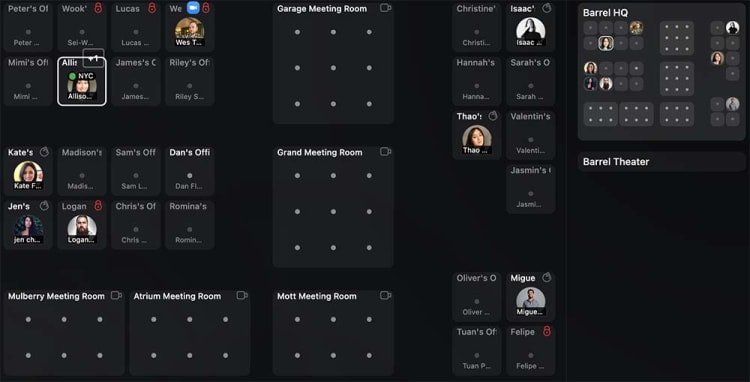The future of work has arrived, and it’s virtual. Imagine a workspace that eliminates the barriers of distance, fosters collaboration, and revolutionizes productivity. Kumospace and Roam Virtual Office are two virtual office platforms that are doing just that, transforming the way we work. In this blog post, we’ll dive deep into Roam’s all-in-one virtual office solution, compare it to the #1 virtual office solution, Kumospace, and examine how these innovative platforms are shaping the future of remote work.
Key takeaways
- Roam Virtual Office is helping to change remote workspaces, offering an all-in-one virtual workspace with immersive audio and visual elements.
- Discover the standard features and security measures that establish Kumospace as the #1 virtual workspace platform.
- Revealing key differences in features such as customization options, user experience, communication capabilities, and meeting scheduling efficiency that distinguish Kumospace from Roam.
What is Roam Virtual Office and how it is changing remote workspaces?
.webp?tx=c_scale,w_1920,h_1086)
Founded by Howard Lerman, Roam Virtual Office is virtual office software designed to enhance communication among employees. It recreates the in-person office experience and aims to foster serendipity, thus supporting remote teams, irrespective of their physical locations, and benefiting all employees. The platform offers a bird’s eye view of the virtual office, making it easier to locate and interact with colleagues.
Roam is attempting to provide companies with a platform for managing their operations. Through this, Roam hopes to give them access to features similar to those found in:
Roam aims to enhance collaboration and communication among team members through a virtual work environment, making it an option for companies seeking a virtual office solution. Users can schedule Roam meetings directly from Google Calendar and even set their own entrance music when joining a meeting. With just a few dozen companies adopting Roam to improve productivity, the platform is trying to change the remote workspace experience.
The all-in-one virtual workspace
Roam’s all-in-one virtual workspace offers:
- Shared coworking spaces
- Meeting room
- Private offices
- Virtual office capabilities
- Audio and video meeting rooms
- The ability to host meetings with external parties
Upon logging in, users are presented with various offices, and selecting an office leads to a map-style view that organizes users according to their respective roles, such as R&D, commercial, design, and marketing. Roam’s immersive audio and visual elements create a realistic and engaging atmosphere, which has been adopted by dozens of companies to improve productivity and focus.
Immersive audio and visual elements
Roam Virtual Office provides the following features:
- Audio-only virtual rooms for communication
- Video and audio rooms for communication
- Immersive and productive virtual office experience
- Engaging and interactive virtual office environment
- Flexibility of both video and audio meetings
- Catering to different communication needs
- Fostering a sense of connectedness even when working remotely
Roam claims that its immersive audio and visual elements create a more engaging and interactive environment, connecting users with the virtual workspace and simulating the ambiance of a physical office. This enhanced user experience makes Roam an option for companies looking to:
- Improve productivity
- Maintain a company culture
- Facilitate collaboration
- Improve communication
- Enhance employee engagement
In today’s fast-paced business environment, a few dozen companies have tried Roam for their employees during the beta period. The company says it helps ensure flexibility and productivity while saving on office rent. Their user interface approach provides a bird’s eye view of the entire team’s performance, which can make it easier to manage and coordinate tasks.
Comparing Roam and Kumospace: what makes Kumospace #1?

Roam and Kumospace both provide innovative virtual office solutions tailored to the needs of remote teams. Kumospace stands out with its communication-rich features, such as combining video conferencing and team chat, customizable office layouts, and interactive elements like shared screens and whiteboards. All these features make it easy for team members to operate as if they were in an actual office setting. Kumospace's all-in-one business communication tool has been adopted by thousands of enterprises and SMB customers. By comparison, Roam is still in beta, with dozens of companies adopting the product.
Both Roam and Kumospace focus on reducing meeting time and fostering better team collaboration through great visibility, and providing a sense of togetherness even when working remotely. Kumospace has case studies of customers reporting over 30% boosts in productivity and a system that can scale to support the likes of Google Cloud’s annual conference in 2021. Where the platforms differ is that they have their own unique approaches to the user experience, virtual interactions, and customization options. When picking the product that is right for you, it's best to consider these two strong contenders in the virtual office space market, and pick the solution that best fits your needs.
Kumospace: leading innovation for virtual interactions
Kumospace is reshaping the virtual office experience with its industry-leading approach to crafting virtual environments that replicate real-world interactions. The platform offers a spatial audio feature, where the volume of other participants’ voices changes based on their virtual proximity. This creates a more immersive and realistic communication experience, fostering a stronger sense of connectedness among remote team members.
Additionally, Kumospace provides fully customizable office layouts and productivity-boosting interactive elements like shared screens and whiteboards. These features, combined with the platform’s user-friendly interface, ensure a smooth transition for teams and reduce the learning curve often associated with virtual office tools.

Kumospace is the highest-rated virtual workspace product on G2. With its unique blend of immersive experience and intuitive design, Kumospace is a top choice for teams seeking a dynamic and efficient way to stay connected and productive.
Kumospace is built for enterprise, while Roam is not
Kumospace is capable of supporting companies with tens of thousands of employees and counts some of the world's largest companies among its clients. The product also boasts industry-leading security and data protection measures.
In contrast, Roam states in their FAQ that its product is a fully developed and operational virtual office platform, currently only available for companies with fewer than 49 people.
Customization and user experience
Both Kumospace and Roam offer customization options for their virtual office platforms. Roam enables extensive customization using HTML elements, CSS, and JavaScript. In contrast, Kumospace offers customization through user-friendly drag-and-drop floor plans, furniture, interactive elements, and integrations with essential business tools. Users can tailor their virtual workspaces to meet their specific needs, preferences, and company culture.
Kumospace boasts an intuitive design with simple and realistic-looking room layouts and tools, enhancing user navigation and collaboration within the virtual workspace. On the other hand, Roam is known for its map design, aimed at bringing dispersed teams together in a fluid and engaging manner. Both platforms excel in delivering a seamless and efficient virtual office experience for their users.
Kumospace: virtual office provider with enterprise-grade security and data protection
In the constantly evolving landscape of virtual office software, robust security and data protection measures are paramount. Kumospace, as the industry leader in security, data protection, and privacy, emerges as the preferred choice for large enterprises and companies seeking the highest level of security.
What virtual workspace platform is HIPAA, SOC 2, and GDPR compliant?
Kumospace is a virtual office platform that is compliant with GDPR, SOC 2, and HIPAA. The company's SOC 2 certification signifies that both Kumospace and its comprehensive business communication products meet stringent data protection standards.
Kumospace, with a customer base that spans from startups to Fortune 500 companies, proudly holds the distinction of having the best-in-class security measures among virtual workspace providers. Founded by a former software engineer from Google and Oscar Healthcare, Kumospace has prioritized building enterprise-grade security and data protection as standard features for all users, regardless of their pricing tier. This is achieved by leveraging WebRTC, a framework developed by Google and used by Apple, for its video and audio functionalities. WebRTC ensures secure business communication in Kumospace by using proven encryption technologies within users' browsers and native apps. All data, whether at rest or in transit, is subject to rigorous encryption, and access is meticulously controlled.
Kumospace is a virtual HQ provider with SOC 2 certification, showcasing its commitment to the highest security and data standards as outlined by the American Institute of Certified Public Accountants (AICPA).
Within Kumospace's Enterprise plans, customers have the option to ensure their virtual workspace is fully Health Insurance Portability and Accountability Act (HIPAA) compliant. This feature makes it a preferred solution for healthcare, biotech, and pharmaceutical companies looking to benefit from utilizing a virtual HQ.
Picking the right virtual office solution
Roam and Kumospace are excellent options for companies looking to address the challenges of remote and hybrid work environments. When selecting a solution, it's important to consider what is most important to your company.
Kumospace is the industry leader and preferred solution for enterprise companies operating in highly regulated industries across multiple continents. It also serves numerous startups and small to midsize businesses. Moreover, the leadership team at Kumospace has made significant investments in top-tier security and data protection.
Roam and Kumospace have adopted different visual approaches in developing virtual workspace software. Sometimes, when choosing software, it can be as simple as selecting the solution that is most visually appealing to you.
Boosting efficiency with a virtual HQ: how it streamlines meetings and communication

Virtual HQs such as Kumospace and Roam offer the following features to enhance the efficiency and productivity of remote work:
- Cloud-based headquarters that encourage personality, visibility, collaboration, and culture.
- Less formal interaction and collaboration as if employees were in one physical location
- Team chat, video conferencing, and project presence through an app View in both Roam and Kumospace for effortless engaging in impromptu problem-solving distributed teams
Reducing average meeting times

The dozen or so companies utilizing Roam’s cloud HQ have recorded an average meeting time of merely 8 minutes and 30 seconds, a substantial reduction compared to the standard 30 or 60 minutes Zoom meetings.
Kumospace's thousands of customers report a similar reduction in meeting times, with the average meeting in Kumospace lasting just 9 minutes.
Roam says that Audio-only meetings on their platform can facilitate shorter meeting durations by eliminating visual distractions and focusing participants’ attention on the content and discussion.
Roam and Kumospace's platforms both provide features that can help to reduce meeting times, such as:
- Easy access to co-workers for quick and informal communication, reducing the need for formal meetings
- Streamlining communication, enabling employees to work more efficiently and effectively
- Ultimately reducing the average meeting times
The future of Roam: expansion plans and new features
Roam looks to someday support companies larger than 49 employees and add enterprise security certifications.
For now, Roam envisions a future of offering virtual HQs to distributed teams. The company has procured $40 million in funding, and is committed to creating a distinct virtual office space and enhancing employee communications. Roam’s expansion plans are focused on delivering an improved virtual workplace experience and becoming a more robusts solution for businesses in various markets. With new features and improvements on the horizon, Roam is poised to take their product out of beta and hopes to expand its customer base.
In the near future, Roam Virtual Office will be introducing the following updates:
- Guest badges
- Major enhancements to meeting scheduling
- Support companies with greater than 49 employees
- Better reliability and performance
- Introduction of Cloud Rooms for hybrid meetings, allowing users to connect physical conference rooms to virtual meeting rooms within the platform
These updates are aimed at boosting collaboration and communication for employees in various offices and remote workers.
Expanding the Roam ecosystem

Roam is aiming to expand its ecosystem by tapping into new markets and pursuing external partnerships in areas such as interior design, hospitality, robotics, and roaming management systems. The platform’s expansion plans include entering markets like Georgia, Arizona, Colorado, Texas, and Florida. By broadening its reach, Roam is set to become an even more integral part of the remote work landscape. By contracts, Kumospace already touts users in every time zone and on every continent except Antarctica.
The expansion of the Roam ecosystem is anticipated to have a beneficial impact on its users, providing them with increased access to ecological resources and improved productivity. Moreover, the growth of the Roam ecosystem is expected to bring new features and technologies, including VoLTE and 5G, which will further enhance the user experience.
Roam's role in the Miami tech scene
The two largest tech scenes in the world are in New York City and Silicon Valley. Over the past three to four years, Miami has begun to see a nascent tech scene develop.
Given the small size of Miami's tech scene and Howard's background, Roam holds a significant position within it, aiding local startups and contributing to the city's desire to become a tech hub. The platform has made a considerable investment in the Miami tech scene, securing a $30 million Series A funding round and receiving a $10.6 million contribution from its founder. These investments have been instrumental in driving the growth and development of Miami's tech ecosystem.
Roam is actively engaged in promoting the growth of the Miami tech scene by providing an improved virtual workplace environment for businesses within the tech ecosystem. By fostering innovation and encouraging startups in the county, Roam is contributing to the development of Miami as a thriving tech hub.
Supporting local startups

Roam pledges to support local startups in Miami by building the Miami tech ecosystem and offering a high-quality virtual workplace environment. Roam’s virtual office space offers new startups access to meeting spaces, a professional business address, and a virtual workplace for remote collaboration. This reduces overhead costs, improves time management, increases productivity, and allows startups to attract top talent.
Roam has provided support to a number of tech startups in Miami, such as:
By fostering the growth of these startups, Roam is playing a key role in shaping the future of the Miami tech scene.
Summary
In conclusion, Kumospace is revolutionizing the remote work landscape by setting the industry standard for virtual office software. The company offers the only product that is SOC 2, GDPR, and HIPAA compliant and can support thousands of users. In August 2023, Kumospace further solidified its position as the market leader by acquiring its nearest competitor, Kosy.
Roam Virtual Office serves as an alternative to Kumospace, but is best suited for small companies, with the product being available only to teams of fewer than 49 employees. The leadership team at Roam is passionate about what they are building and aims to expand functionality to support larger organizations. The company also plans to eventually achieve SOC 2, GDPR, and HIPAA compliance at an unknown future date.
Both these innovative virtual office platforms foster collaboration, boost productivity, and streamline communication. With their unique features, customization options, and immersive audio and visual capabilities, these platforms are shaping the future of work and transforming the way remote teams collaborate.
As Roam continues to expand its ecosystem and support local startups, the platform hopes to make a lasting impact on the tech scene in Miami and beyond.
Frequently Asked Questions
No, as of now, Roam Virtual Office is not SOC 2 compliance. This standard, developed by the American Institute of CPAs (AICPA), is a crucial framework for technology companies, especially those dealing with customer data. SOC 2 compliance is an indication that a company adheres to high standards of data security and privacy. The absence of this compliance in Roam Virtual Office raises concerns about its data management and protection protocols. While the company states that they have security measures in place, without SOC 2 certification, it lacks the formal recognition of meeting the rigorous data security and privacy benchmarks that are increasingly becoming a norm in the industry.
Kumospace is the only virtual office software that has achieved SOC 2 compliance.
Roam Virtual Office currently does not comply with the General Data Protection Regulation (GDPR), the stringent data protection law that governs the handling of personal data within the European Union. The GDPR sets forth rigorous requirements for data privacy and security, ensuring that organizations manage personal data responsibly and transparently. Due to its non-compliance with GDPR, Roam Virtual Office may not be the right fit for companies based within, or those who frequently do business with, the European Union.
Roam Virtual Office is currently not compliant with the Health Insurance Portability and Accountability Act (HIPAA), a critical regulation in the United States that sets the standard for protecting sensitive patient data. This non-compliance indicates that Roam Virtual Office may not have the necessary safeguards to ensure the confidentiality, integrity, and security of protected health information (PHI). For healthcare providers, insurers, and other entities dealing with PHI, compliance with HIPAA is a requirement for conducting business. Without adhering to HIPAA standards, Roam Virtual Office might be unsuitable for use by any organization in the healthcare sector or those handling health-related information.
Roam Cloud HQ is an all-in-one workspace for distributed teams to help them stay productive and connected. It features a cloud headquarters with tools like floor plans, in/out signs, and virtual meeting rooms, allowing companies to function as if they were together in one place.
Roam provides remote companies with their own virtual headquarters, enabling increased productivity and efficiency by bringing teams together.
Howard Lerman is the Founder and CEO of Roam.
A virtual office is a service that allows businesses to benefit from a professional business address and telephone answering services without having to pay for a full-time office rental. It also provides access to conference rooms, physical workspaces, and other tools such as videoconferencing and messaging services.
Roam Virtual Office distinguishes itself with communication-rich features, including audio-only and video and audio rooms, along with an intuitive map view that simulates an actual office setting. The platform also provides a comprehensive remote collaboration experience, offering customizable offices, conference rooms, and seamless integration with company workflows, setting it apart from other virtual workplace apps.
Top Roam alternatives provide customizable virtual headquarters, seamless collaboration and communication, as well as adaptable virtual rooms to suit a wide range of requirements.
Roam Virtual Office integrates with Google Calendar by allowing you to select Roam from the “Add video conferencing” dropdown or schedule an event through the 'Schedule in Roam' button.
Roam Virtual Office offers a range of tools to enhance remote team collaboration and communication, such as customizable virtual spaces and communication tools. This helps to create a comprehensive digital workspace solution for remote teams.
Kumospace provides a more engaging and immersive spatial experience than Roam, encouraging natural interactions and helping to reduce virtual meeting fatigue.





